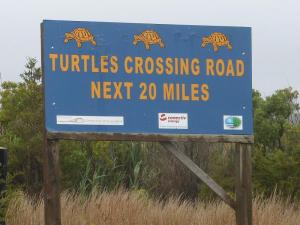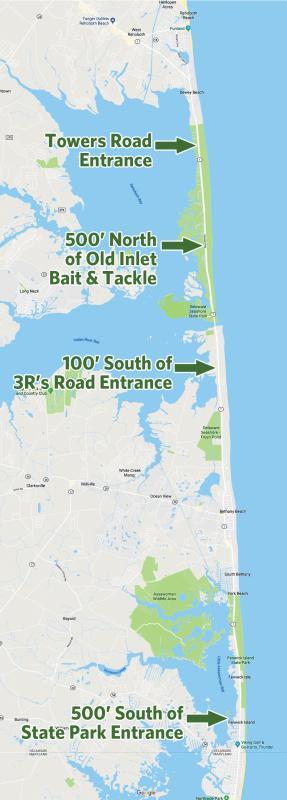To the benefit of the Inland Bays’ terrapin turtles, new signs on Route 1 warning drivers of their existence are going to be installed soon. Unfortunately, it may be too late – the female nesting season began weeks ago.
Every summer, from the end of May to the end of July, female terrapins that call Coastal Delaware’s Inland Bays home lay their eggs.
Some dig holes on the bays’ beaches, but many attempt to cross Route 1 from Dewey Beach to Fenwick Island to lay their eggs in the dunes on the ocean side of the highway.
Since the early 2000s, the Delaware Department of Natural Resources and Environmental Control has overseen the annual installation of terrapin fencing to deter adventurous turtle behavior. Big blue signs with bright yellow letters along that stretch of heavily traveled highway warn drivers of the slow movers.
This year, for the first few weeks of nesting season, there have been no signs warning unknowing tourists of the turtles. As of June 5, new, more-noticable signs have yet to be installed.
Vickie Henderson of Delaware Council of Wildlife Rehabilitators and Educators said it was a bad time of year for the signs to not be up. For the most part, people who live in this area are aware of the turtles; it’s the drivers making that trip for the first time who aren’t.
“It’s a shame,” she said.
Henderson said she’s heard reports of up to eight turtles hit in a day this year, but she said she’s getting about the same number of turtles as usual delivered to the Smyrna-based rehabilitation center.
Amy Barra, Delaware Center for the Inland Bays outreach and education coordinator, said the warning signs are taken down every winter, and then put back up every spring, to avoid excessive wear and tear from winter storms. Four new signs were delivered about a week ago, she said, and were scheduled to be put up during the first available opportunity.
“They had extremely outdated logos and imagery,” Barra said of the old signs. The signs will be placed in the original locations as the old ones, she said, adding that it takes a team because each one is heavy.
The center has been receiving calls about hit turtles, but Barra said there’s no good estimate for how many turtles have been hurt.
Barra said there isn’t a good understanding of the Inland Bays’ terrapin population, but the center is currently conducting studies to determine opportunities to better understand it.
Suzanne Thurman, Marine Education, Research and Rehabilitation Institute executive director, said the turtles have started nesting a little early this year and that June is the prime month.
Thurman said MERR gets dozens of calls every year about turtle species, especially during nesting season, that don’t fall under their watch, but she said MERR usually assists in getting the turtles to an appropriate rehabber. She said MERR will also guide the public to assist an uninjured turtle in getting to its appropriate destination.
Thurman said there was talk of tunnels and a netting barricade to halt the turtles from crossing the highway, but she said that would take a lot of volunteer effort because it requires manually moving the turtles to the nesting area and back again. It would also be useful later in the season during hatching time to catch the hatchlings and move them back to the bayside, she said.
Thurman said the signs help by heightening awareness, but motorists go so fast in that area she questions if drivers can stop in time to avoid hitting turtles.
“It is so unfortunate that a highway now runs between the terrapin's bay habitat and nesting beach,” said Thurman.
DNREC did not respond to requests for comment.
Chris Flood has been working for the Cape Gazette since early 2014. He currently covers Rehoboth Beach and Henlopen Acres, but has also covered Dewey Beach and the state government. He covers environmental stories, business stories and random stories on subjects he finds interesting, and he also writes a column called Choppin’ Wood that runs every other week. He’s a graduate of the University of Maine and the Landing School of Boat Building & Design.





















































